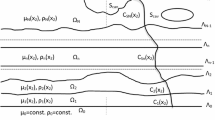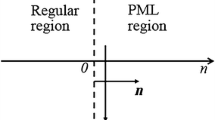Abstract
Accurate seismic wave modeling of viscoelastic anisotropic medium is a fundamental tool for seismic data processing, interpretation and full waveform inversion. Also, free water surface, topographic relief and irregular seabed are often encountered in practical seismic surveys. Thus, basing on the General Maxwell Body, we proposed a generalized matrix form of the velocity-stress seismic wave equation, which becomes valid for composite viscoelastic anisotropic media and satisfies the boundary conditions in presence of topographic free surfaces and irregular fluid–solid interfaces. We theoretically show that the viscoelastic effect of a medium may be considered as the intrinsic body sources accumulated in wavefield history and computed by a recursive convolution formula accurately and efficiently. We also demonstrated that such a generalized viscoelastic wave equation may be solved with the curvilinear MacCormack finite difference method and validated the accuracy and feasibility of the proposed method. The modeling results in homogeneous and heterogeneous media match well with the analytical solutions and the references yielded by the spectral element solutions.
Similar content being viewed by others
Data availability
Data sharing not applicable to this article as no datasets were generated during the current study.
Code availability
The analytical solution code is download from Seismic wave Propagation and Imaging in Complex media: a European network (SPICE) website (EX2DDIR/ EX2DELEL package, http://www.spice-rtn.org/library/software.1.html) The spectral element code is downloaded from the Computational Infrastructure for Geodynamics (CIG) website (SPECFEM2D package, https://geodynamics.org/cig/software/ specfem2d/).
References
Aki, K., Richards, P. G.: Quantitative seismology: Theory and methods, San Francisco, California (1980)
Appelö, D., Petersson, N.A.: A stable finite difference method for the elastic wave equations on complex geometries with free surfaces. Comm. Comput. Phys. 5, 84–107 (2009)
Bai, T., Tsvankin, I.: Time-domain finite-difference modeling for attenuative anisotropic media. Geophysics 81, C69–C77 (2016). https://doi.org/10.1190/geo2015-0424.1
Blanch, J.O., Robertsson, J.O., Symes, W.W.: Modeling of a constant Q; methodology and algorithm for an efficient and optimally inexpensive viscoelastic technique. Geophysics 60, 176–184 (1995). https://doi.org/10.1190/1.1443744
Cao, D., Yin, X.: Equivalence relations of generalized rheological models for viscoelastic seismic-wave modeling. Bull. Seismol. Soc. Am. 104(1), 260–268 (2014). https://doi.org/10.1785/0120130158
Cao, J., Chen, J.B.: A parameter-modified method for implementing surface topography in elastic-wave finite-difference modeling. Geophysics 83, T313–T332 (2018). https://doi.org/10.1190/geo2018-0098.1
Carcione, J. M.: Wave fields in real media: Theory and numerical simulation of wave propagation in anisotropic, anelastic, porous and electromagnetic media. Elsevier, New York (2007)
Chaljub, E., Komatitsch, D., Vilotte, J.P., Capdeville, Y., Valette, B., Festa, G.: Spectral-element analysis in seismology. Adv. Geophys. 48, 365–419 (2007). https://doi.org/10.1016/S0065-2697(06)48007-9
Chen, J.B., Cao, J., Li, Z.: A comparative study on the stress image and adaptive parameter-modified methods for implementing free surface boundary conditions in elastic wave numerical modeling. Geophysics 86, T451–T467 (2021). https://doi.org/10.1190/geo2020-0418.1
de Hoop, A.T.: Pulsed electromagnetic radiation from a line source in a two-media configuration. Radio Sci. 14, 253–268 (1979). https://doi.org/10.1029/RS014i002p00253
de la Puente, J., Ferrer, M., Hanzich, M., Castillo, J.E., Cela, J.M.: Mimetic seismic wave modeling including topography on deformed staggered grids. Geophysics 79(2), T125–T141 (2014). https://doi.org/10.1190/geo2013-0371.1
Dong, S.L., Chen, J.B., Li, Z.: Viscoelastic wave finite-difference modeling in the presence of topography with adaptive free-surface boundary condition. Acta Geophys. 69, 2205–2217 (2021). https://doi.org/10.1007/s11600-021-00666-7
Dong, S.L., Zhou, X.H., Chen, J.B.: Finite-difference modeling with topography using 3D viscoelastic parameter-modified free-surface condition. Geophysics 88, T211–T226 (2023). https://doi.org/10.1190/geo2022-0556.1
Emmerich, H., Korn, M.: Incorporation of attenuation into time-domain computations of seismic wave fields. Geophysics 52, 1252–1264 (1987). https://doi.org/10.1190/1.1442386
Fornberg, B.: The pseudospectral method: Accurate representation of interfaces in elastic wave calculations. Geophysics 53, 625–637 (1988). https://doi.org/10.1190/1.1442497
Graves, R.W.: Simulating seismic wave propagation in 3D elastic media using staggered-grid finite differences. Bull. Seismol. Soc. Am. 86, 1091–1106 (1996)
Hixon, R., Turkel, E.: Compact implicit MacCormack-type schemes with high accuracy. J. Comput. Phys. 158, 51–70 (2000). https://doi.org/10.1006/jcph.1999.6406
Igel, H., Mora, P., Riollet, B.: Anisotropic wave propagation through finite-difference grids. Geophysics 60, 1203–1216 (1995). https://doi.org/10.1190/1.1443849
Jin, C., Zhou B., Greenhalgh, S., Won, M., Riahi, M.K., Zemerly, M. J.: Generalized recursive convolution method for viscoelastic wave modelling. 84th EAGE Annual Conference & Exhibition, (2023). https://doi.org/10.3997/2214-4609.202310142
Kelley, D. F., Luebbers, R. J.: Piecewise linear recursive convolution for dispersive media using FDTD. IEEE Trans. Antennas Propag. 44, 792–797 (1996). https://doi.org/10.1109/8.509882
Konuk, T., Shragge, J.: Tensorial elastodynamics for anisotropic media. Geophysics 86(4), T293–T303 (2021). https://doi.org/10.1190/geo2020-0156.1
Kristek, J., Moczo, P., Galis, M.: Stable discontinuous staggered grid in the finite-difference modelling of seismic motion. Geophys. J. Int. 183, 1401–1407 (2010). https://doi.org/10.1111/j.1365-246X.2010.04775.x
Kristek, J., Moczo, P.: Seismic-wave propagation in viscoelastic media with material discontinuities: A 3D fourth-order staggered-grid finite-difference modeling. Bull. Seismol. Soc. Am. 93, 2273–2280 (2003). https://doi.org/10.1785/0120030023
Lan, H., Zhang, Z.: Three-dimensional wave-field simulation in heterogeneous transversely isotropic medium with irregular free surface. Bull. Seismol. Soc. Am. 101, 1354–1370 (2011). https://doi.org/10.1785/0120100194
Liu, X., Chen, J., Zhao, Z., Lan, H., Liu, F.: Simulating seismic wave propagation in viscoelastic media with an irregular free surface. Pure Appl. Geophys. 175, 3419–3439 (2018). https://doi.org/10.1007/s00024-018-1879-9
Liu, X.: Modeling seismic waves in ocean with the presence of irregular seabed and rough sea surface. J. Geophys. Eng. 20, 49–66 (2023). https://doi.org/10.1093/jge/gxac093
Luebbers, R., Hunsberger, F.P., Kunz, K.S., Standler, R.B., Schneider, M.: A frequency-dependent finite-difference time-domain formulation for dispersive materials. IEEE Trans. Electromagn. Compat. 32, 222–227 (1990). https://doi.org/10.1109/15.57116
MacCormack, R.W.: The effect of viscosity in hypervelocity impact cratering. Frontiers of Computational Fluid Dynamics. 27–43 (2002). https://doi.org/10.1142/9789812810793_0002
Mavko, G., Mukerji, T., Dvorkin, J.: The rock physics handbook. Cambridge University Press. (2020). https://doi.org/10.1017/9781108333016
Moczo, P., Kristek, J., Galis, M., Pazak, P., Balazovjech, M.: The finite-difference and finite-element modeling of seismic wave propagation and earthquake motion. Acta Phys. Slovaca 57 (2007). https://doi.org/10.2478/v10155-010-0084-x
Moczo, P., Kristek, J., Galis, M.: The finite-difference modelling of earthquake motions: Waves and ruptures. Cambridge University Press. (2014). https://doi.org/10.1017/CBO9781139236911
Moczo, P., Kristek, J., Halada, L.: 3D fourth-order staggered-grid finite-difference schemes: Stability and grid dispersion. Bull. Seismol. Soc. Am. 90, 587–603 (2000). https://doi.org/10.1785/0119990119
Moczo, P., Kristek, J.: On the rheological models used for time-domain methods of seismic wave propagation. Geophys. Res. Lett. 32 (2005) https://doi.org/10.1029/2004gl021598
Moczo, P., Robertsson, J.O., Eisner, L.: The finite-difference time-domain method for modeling of seismic wave propagation. Adv. Geophys. 48, 421–516 (2007). https://doi.org/10.1016/S0065-2687(06)48008-0
Pan, Y., Gao, L., Bohlen, T.: High-resolution characterization of near-surface structures by surface-wave inversions: From dispersion curve to full waveform. Surv. Geophys. 40, 167–195 (2019). https://doi.org/10.1007/s10712-019-09508-0
Qiao, Z., Sun, C., Wu, D.: Theory and modelling of constant-Q viscoelastic anisotropic media using fractional derivative. Geophys. J. Int. 217, 798–815 (2019). https://doi.org/10.1093/gji/ggz050
Robertsson, J.O., Blanch, J.O., Symes, W.W.: Viscoelastic finite-difference modeling. Geophysics 59, 1444–1456 (1994). https://doi.org/10.1190/1.1443701
Sethi, H., Shragge, J., Tsvankin, I.: Mimetic finite-difference coupled-domain solver for anisotropic media. Geophysics 86(1), T45–T59 (2021). https://doi.org/10.1190/geo2020-0092.1
Sethi, H., Shragge, J., Tsvankin, I.: Tensorial elastodynamics for coupled acoustic/elastic anisotropic media: Incorporating bathymetry. Geophys. J. Int. 228, 999–1014 (2022). https://doi.org/10.1093/gji/ggab374
Sun, Y.C., Zhang, W., Chen, X.: 3D seismic wavefield modeling in generally anisotropic media with a topographic free surface by the curvilinear grid finite-difference method 3D seismic wavefield modeling in generally anisotropic media. Bull. Seismol. Soc. Am. 108, 1287–1301 (2018). https://doi.org/10.1785/0120170154
Sun, Y.C., Zhang, W., Chen, X.: Seismic-wave modeling in the presence of surface topography in 2D general anisotropic media by a curvilinear grid finite-difference method. Bull. Seismol. Soc. Am. 106, 1036–1054 (2016). https://doi.org/10.1785/0120150285
Sun, Y.C., Zhang, W., Ren, H., Bao, X., Xu, J.K., Sun, N., Yang, Z., Chen, X.: 3D seismic-wave modeling with a topographic fluid-solid Interface at the sea bottom by the curvilinear-grid finite-difference method. Bull. Seismol. Soc. Am. 111, 2753–2779 (2021). https://doi.org/10.1785/0120200363
Sun, Y.C., Zhang, W., Xu, J.K., Chen, X.: Numerical simulation of 2-D seismic wave propagation in the presence of a topographic fluid–solid interface at the sea bottom by the curvilinear grid finite-difference method. Geophys. J. Int. 210, 1721–1738 (2017). https://doi.org/10.1093/gji/ggx257
Tam, C.K., Webb, J.C.: Dispersion-relation-preserving finite difference schemes for computational acoustics. J. Comput. Phys. 107(2), 262–281 (1993). https://doi.org/10.1006/jcph.1993.1142
Tarrass, I., Giraud, L., Thore, P.: New curvilinear scheme for elastic wave propagation in presence of curved topography. Geophys. Prospect. 59, 889–906 (2011). https://doi.org/10.1111/j.1365-2478.2011.00972.x
Tromp, J., Komatitsch, D., Liu, Q.: Spectral-element and adjoint methods in seismology. Comm. Comput. Phys. 3, 1–32 (2008)
Vavryčuk V.: Asymptotic green’s function in homogeneous anisotropic viscoelastic media. Proc. Math. Phys. Eng. Sci. Proc. R. Soc. A-Math. Phys. 463, 2689–2707 (2007). https://doi.org/10.1098/rspa.2007.1862
Virieux, J., Calandra, H., Plessix, R.É.: A review of the spectral, pseudo-spectral, finite-difference and finite-element modelling techniques for geophysical imaging. Geophys. Prospect. 59, 794–813 (2011). https://doi.org/10.1111/j.1365-2478.2011.00967.x
Virieux, J., Operto, S.: An overview of full-waveform inversion in exploration geophysics. Geophysics 74, WCC1-WCC26 (2009). https://doi.org/10.1190/1.3238367
Wang, N., Li, J., Borisov, D., Gharti, H.N., Shen, Y., Zhang, W., Savage, B.: Modeling three-dimensional wave propagation in anelastic models with surface topography by the optimal strong stability preserving Runge-Kutta method. J. Geophys. Res. Solid Earth 124, 890–907 (2019). https://doi.org/10.1029/2018JB016175
Yang, P., Brossier, R., Métivier, L., Virieux, J.: A review on the systematic formulation of 3-D multiparameter full waveform inversion in viscoelastic medium. Geophys. J. Int. 207, 129–149 (2016). https://doi.org/10.1093/gji/ggw262
Yang, Q., Zhou, B., Riahi, M.K., Al-Khaleel, M.: Frequency-domain seismic data transformation from point source to line source for 2D viscoelastic anisotropic media. Geophysics 87, T85–T98 (2022). https://doi.org/10.1190/geo2021-0166.1
Yang, S. B., Zhou, B., Bai, C. Y.: A generalized 2.5-D Time-domain seismic wave equation to accommodate various elastic media and boundary conditions. Pure Appl. Geophys. 178, 2999–3025 (2021). https://doi.org/10.1007/s00024-021-02775-2
Zhang, W., Chen, X.: Traction image method for irregular free surface boundaries in finite difference seismic wave simulation. Geophys. J. Int. 167, 337–353 (2006). https://doi.org/10.1111/j.1365-246X.2006.03113.x
Zhou, B., Moosoo, W., Greenhalgh, S., Liu, X.: Generalized stiffness reduction method to remove the artificial edge effects for seismic wave modelling in elastic anisotropic media. Geophys. J. Int. 220(2), 1394–1408 (2020). https://doi.org/10.1093/gji/ggz529
Zhou, B., Won, M., Jin, C.: New numerical schemes for time-domain seismic wave modeling in viscoelastic media. Second International Meeting for Applied Geoscience & Energy, 2384–2388 (2022). https://doi.org/10.1190/image2022-3751043.1
Zhou, H.W., Hu, H., Zou, Z., Wo, Y., Youn, O.: Reverse time migration: A prospect of seismic imaging methodology. Earth-Sci. Rev. 179, 207–227 (2018). https://doi.org/10.1016/j.earscirev.2018.02.008
Acknowledgements
C. J. thanks the Chinese Scholarship Council and Khalifa University for the financial support.
Author information
Authors and Affiliations
Corresponding author
Ethics declarations
Competing interest
The authors declare that they have no known competing financial interests or personal relationships that could have appeared to influence the work reported in this paper.
Additional information
Publisher's Note
Springer Nature remains neutral with regard to jurisdictional claims in published maps and institutional affiliations.
Rights and permissions
Springer Nature or its licensor (e.g. a society or other partner) holds exclusive rights to this article under a publishing agreement with the author(s) or other rightsholder(s); author self-archiving of the accepted manuscript version of this article is solely governed by the terms of such publishing agreement and applicable law.
About this article
Cite this article
Jin, C., Zhou, B., Riahi, M.K. et al. A generalized time-domain velocity-stress seismic wave equation for composite viscoelastic media with a topographic relief and an irregular seabed. Comput Geosci (2024). https://doi.org/10.1007/s10596-024-10273-2
Received:
Accepted:
Published:
DOI: https://doi.org/10.1007/s10596-024-10273-2




